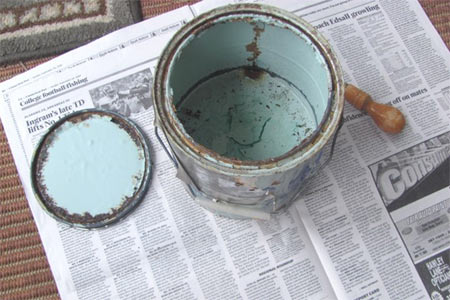How to dispose of leftover paint
Puzzled about how to dispose of leftover paint? Paint can be hazardous waste and as such, it is not the easiest stuff to get rid off. In many countries, it's even illegal to throw paint in the trash because of the damage it does to the environment.
The problem with hazardous waste is that, in most of South Africa, it is simply being mixed with the general waste stream and is then disposed of on unsuitable general landfills that offer no special ground water protection. Chemicals, batteries, heavy metals (mercury, lead, cadmium), paints, pesticides, household cleaning agents, etc. are some of the hazardous wastes being disposed of on our general landfills. [greenstaysa.org]
So where does that leave you? Try these efficient, responsible ways to dispose of paint.
There's a good chance you have a collection of old paint cans cluttering up your garage or garden shed. Before you let it go to waste, determine if your leftover paint is still good. Solvent-based paint has a 15-year shelf life. If you can stir it, it's probably OK to use. Test by stirring and brushing paint onto a newspaper. If there are lumps, the paint is no longer good and needs to be disposed of properly.
When it comes to dumping paint, it's critical to do it in a way that won't cause pollution to drinking water or soil. One 5 litre tin of paint can contaminate thousands of litres of water, harm aquatic fish and plant life, and eventually, poison the food chain. Here are some safe, effective ways to dispose of acrylic and oil-based paints:
How to dispose of acrylic paints
In the absence of any municipal guidelines, it's a considered practice in the US to solidify these paints and throw away with the household trash. Acrylic paints are toxic. To solidify old acrylic paint, pour dry concrete into the paint and stir. After an hour, a cupful of powder should turn latex paint into a thick dough that won't spill or run. In this state, you usually can legally throw away with your regular garbage.
However, it is best to let paint dry in the tin and then peel it out with your hands so that you can toss out the paint and recycle the tin.
How to dispose of oil-based paints
While there are no regulations that govern the disposable of oil-based paints, these products are the most harmful to our environment, and when left on landfills will eventually poison groundwater.
Be sensible when disposing of oil-based products of any kind. Contact your local municipality to find out if they have any programmes in operation for handling hazardous waste.
Other options for leftover paint
If your leftover paint is still good but you want to purge it anyway, there are plenty of ways to reuse it or places to donate it. Here are some of your options:
- Store it for future use.
Leftover paint can be useful for touch-ups and repainting when the time comes. Free up storage space and transfer paint from large cans to small airtight containers. Don't forget to label each container; note the colour and the room where the paint was used, plus the manufacturer's identification number.
- Use it as a base coat.
You can mix leftovers of the same paint type (i.e. acrylic the acrylic, oil with oil) and use it as primer or for undercoating.
- Donate it.
Remember, one man's trash is another man's treasure. If you have several litres that you can't use or don't want, offer the paint to family, friends and neighbours. No takers? Call a local paint contractor; many will be happy to take the cans off your hands.
Some charities may accept paint donations too, especially those that help the elderly with home renovations.
Whatever you do, never pour paints of any type into drains, sewers or waterways. And don't put paint that has not been solidified in the trash, where it can leak and contaminate waterways.

